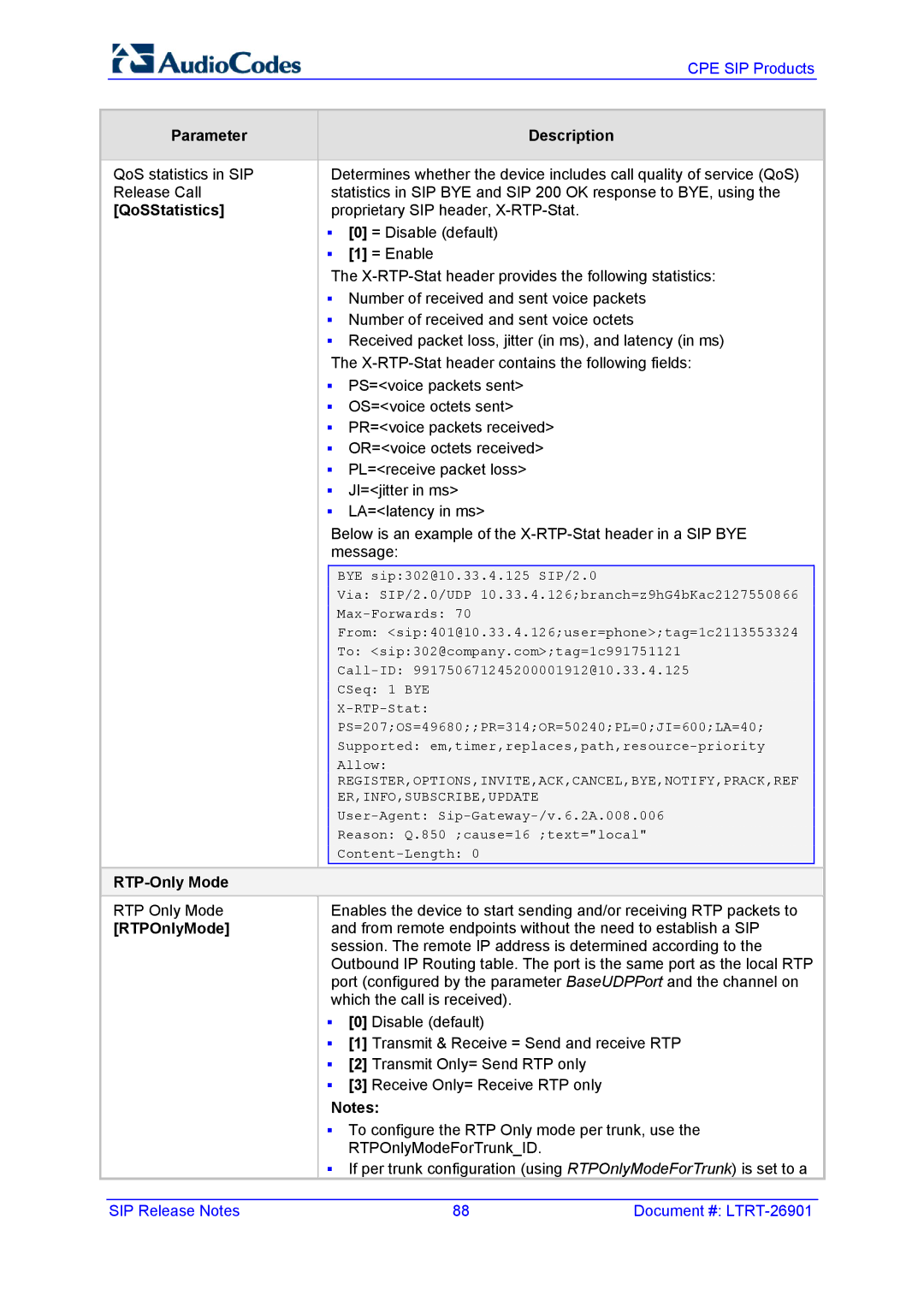|
|
|
| CPE SIP Products |
| |
|
|
|
|
|
|
|
| Parameter |
| Description |
|
|
|
|
|
|
|
|
|
|
| QoS statistics in SIP |
| Determines whether the device includes call quality of service (QoS) |
| ||
| Release Call |
| statistics in SIP BYE and SIP 200 OK response to BYE, using the |
| ||
| [QoSStatistics] |
| proprietary SIP header, |
|
|
|
|
|
| [0] = Disable (default) |
|
|
|
|
|
| [1] = Enable |
|
|
|
|
|
| The |
| ||
|
|
| Number of received and sent voice packets |
| ||
|
|
| Number of received and sent voice octets |
| ||
|
|
| Received packet loss, jitter (in ms), and latency (in ms) |
| ||
|
|
| The |
| ||
|
|
| PS=<voice packets sent> |
|
|
|
|
|
| OS=<voice octets sent> |
|
|
|
|
|
| PR=<voice packets received> |
|
|
|
|
|
| OR=<voice octets received> |
|
|
|
|
|
| PL=<receive packet loss> |
|
|
|
|
|
| JI=<jitter in ms> |
|
|
|
|
|
| LA=<latency in ms> |
|
|
|
|
|
| Below is an example of the |
| ||
|
|
| message: |
|
|
|
|
|
|
|
|
|
|
|
|
| BYE sip:302@10.33.4.125 SIP/2.0 |
|
|
|
|
|
| Via: SIP/2.0/UDP 10.33.4.126;branch=z9hG4bKac2127550866 |
|
| |
|
|
|
|
|
| |
|
|
| From: <sip:401@10.33.4.126;user=phone>;tag=1c2113553324 |
|
| |
|
|
| To: <sip:302@company.com>;tag=1c991751121 |
|
| |
|
|
|
|
| ||
|
|
| CSeq: 1 BYE |
|
|
|
|
|
|
|
|
| |
|
|
| PS=207;OS=49680;;PR=314;OR=50240;PL=0;JI=600;LA=40; |
|
| |
|
|
| Supported: |
|
| |
|
|
| Allow: |
|
|
|
|
|
| REGISTER,OPTIONS,INVITE,ACK,CANCEL,BYE,NOTIFY,PRACK,REF |
|
| |
|
|
| ER,INFO,SUBSCRIBE,UPDATE |
|
|
|
|
|
|
|
| ||
|
|
| Reason: Q.850 ;cause=16 ;text="local" |
|
| |
|
|
|
|
|
| |
|
|
|
|
|
|
|
|
|
|
|
|
|
|
| RTP Only Mode |
| Enables the device to start sending and/or receiving RTP packets to |
| ||
| [RTPOnlyMode] |
| and from remote endpoints without the need to establish a SIP |
| ||
|
|
| session. The remote IP address is determined according to the |
| ||
|
|
| Outbound IP Routing table. The port is the same port as the local RTP |
| ||
|
|
| port (configured by the parameter BaseUDPPort and the channel on |
| ||
|
|
| which the call is received). |
|
|
|
|
|
| [0] Disable (default) |
|
|
|
|
|
| [1] Transmit & Receive = Send and receive RTP |
| ||
|
|
| [2] Transmit Only= Send RTP only |
|
|
|
|
|
| [3] Receive Only= Receive RTP only |
|
|
|
|
|
| Notes: |
|
|
|
|
|
| To configure the RTP Only mode per trunk, use the |
| ||
|
|
| RTPOnlyModeForTrunk_ID. |
|
|
|
|
|
| If per trunk configuration (using RTPOnlyModeForTrunk) is set to a |
| ||
|
|
|
|
|
|
|
| SIP Release Notes | 88 | Document #: |
| ||
